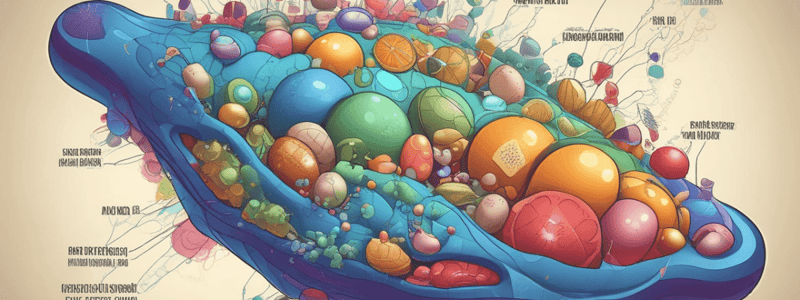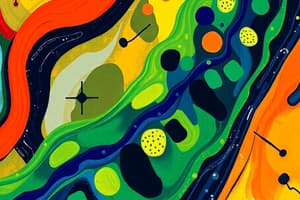Podcast
Questions and Answers
What is the primary function of liver glycogen?
What is the primary function of liver glycogen?
- To maintain constant levels of glucose in the blood (correct)
- To act as a fuel source for the liver tissue
- To provide a rapid source of glucose for muscle contraction
- To regulate the activity of glycogen synthetase
What is the approximate amount of glycogen stored in the liver?
What is the approximate amount of glycogen stored in the liver?
- 100-120g (correct)
- 150-180g
- 300-350g
- 200-250g
What is the primary function of muscle glycogen?
What is the primary function of muscle glycogen?
- To provide a rapid source of glucose for muscle contraction (correct)
- To act as a fuel source for the liver tissue
- To regulate the activity of glycogen phosphorylase
- To maintain constant levels of glucose in the blood
What is the approximate amount of glycogen stored in the muscle?
What is the approximate amount of glycogen stored in the muscle?
What is the key enzyme responsible for the conversion of glucose to glycogen?
What is the key enzyme responsible for the conversion of glucose to glycogen?
What is the characteristic structure of glycogen?
What is the characteristic structure of glycogen?
What type of linkages are present in glycogen?
What type of linkages are present in glycogen?
What is the role of ATP or UTP or GTP in biosynthetic pathways?
What is the role of ATP or UTP or GTP in biosynthetic pathways?
What is the characteristic of the enzyme reactions at the beginning or end of a biosynthetic pathway?
What is the characteristic of the enzyme reactions at the beginning or end of a biosynthetic pathway?
What is the product of the reaction between glucose-1-P and UTP?
What is the product of the reaction between glucose-1-P and UTP?
What is the role of glycogen synthase in glycogen synthesis?
What is the role of glycogen synthase in glycogen synthesis?
What is the approximate number of units introduced by the branching enzyme?
What is the approximate number of units introduced by the branching enzyme?
What is the site of action of the branching enzyme?
What is the site of action of the branching enzyme?
What is the role of glycogenin in glycogen synthesis?
What is the role of glycogenin in glycogen synthesis?
What is the product of glycogen breakdown by phosphorylase?
What is the product of glycogen breakdown by phosphorylase?
What is the function of the debranching enzyme in glycogen breakdown?
What is the function of the debranching enzyme in glycogen breakdown?
What is the effect of adrenaline on glycogen phosphorylase?
What is the effect of adrenaline on glycogen phosphorylase?
What is the role of calcium ions in muscle glycogen breakdown?
What is the role of calcium ions in muscle glycogen breakdown?
What is the effect of high glucose levels on liver glycogen phosphorylase?
What is the effect of high glucose levels on liver glycogen phosphorylase?
What is the role of protein kinase in glycogen synthase regulation?
What is the role of protein kinase in glycogen synthase regulation?
What is the effect of AMP on glycogen phosphorylase?
What is the effect of AMP on glycogen phosphorylase?
What is the site of action of glycogen phosphorylase?
What is the site of action of glycogen phosphorylase?
Study Notes
Glycogen Synthesis and Regulation
- Glycogen is a branched polymer with α-1,4 and α-1,6 glycoside links.
- The liver stores 100-120g of glycogen, while muscles store 250-300g.
- Liver glycogen is sensitive to blood glucose concentration and regulates it under insulin and glucagon control.
- Muscle glycogen is sensitive to energy needs and responds to adrenaline, calcium, AMP, and ATP.
Structure of Glycogen
- Glycogen has a branched structure, with α-1,6 links at the terminal residues.
- The branched structure is important for its physiological function.
Biosynthetic Pathways
- ATP, UTP, or GTP are needed as cofactors to drive reactions forward.
- One or more enzyme reactions are irreversible, and alternative enzymes are used for the opposite direction.
- Enzyme reactions at the beginning or end of the pathway are tightly regulated.
Glycogen Synthesis from Glucose
- Glucose-1-P is converted to UDP-glucose in the presence of UTP and pyrophosphatase.
- UDP-glucose is then added to a protein primer (glycogenin) by glycogen synthase.
- Glycogen synthase and branching enzyme produce the branched structure of glycogen.
Regulation of Glycogen Synthesis
- Glycogen synthase is regulated by phosphorylation, which inactivates the enzyme.
- Regulation of glycogen synthase is controlled by protein kinase and protein phosphatase.
Glycogen Breakdown
- Glycogen breakdown is initiated by glycogen phosphorylase, which removes glucose units from branched regions.
- The breakdown of straight chain regions requires glycogen phosphorylase acting on 1,4 links.
- Release of free glucose occurs through the production of glucose-1-phosphate, which is then converted to glucose-6-phosphate.
Regulation of Glycogen Phosphorylase
- Glycogen phosphorylase is regulated by protein kinase and protein phosphatase.
- Additional controls: liver responds to insulin/glucagon, and muscle responds to adrenaline, calcium, AMP, and ATP.
Additional Controls
- In the liver, insulin inactivates glycogen phosphorylase, while glucagon activates it.
- In muscle, calcium ions released during contraction bind to calmodulin, activating glycogen phosphorylase kinase, which in turn activates phosphorylase.
- In prolonged exercise, AMP is an allosteric activator of glycogen phosphorylase.
Studying That Suits You
Use AI to generate personalized quizzes and flashcards to suit your learning preferences.
Related Documents
Description
This quiz covers the synthesis and regulation of glycogen, its importance in maintaining blood glucose levels, and its relevance to nutrition and metabolism. It is suitable for MBBS students in their first stage.




